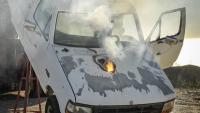-
Syria is continuing to use chemical weapons against its people: Diplomats
Diplomats attending the annual meeting of the Organization for the Prohibition of Chemical Weapons (OPCW) in The Hague, on Monday accused Syrian president Bashar al-Assad of continuing to use deadly gas munitions against his own people, although Syria committed to dismantle and remove all of its stocks of chemical weapons. U.S. and EU representatives charged that the regime may still has in its possession large quantities of chemical armaments like sulfur mustard and sarin, which it has concealed from international inspectors.
-
-
Israel-Russia communication: Straying Russian plane avoid being shot down

Israel defense minister, Moshe Ya’alon, on Sunday told reporters that a Russian jet recently entered Israeli airspace but was not shot down because Israel and Russia had established an effective open communication system between the two countries. Ya’alon said the plane, by mistake, entered about one mile into Israeli airspace and immediately turned around back to Syria when the Russians were notified.
-
-
Turkey’s, Russia’s official versions of jet shoot down scientifically impossible: Physicists
Two astrophysicists show that the official versions of both Turkey and Russia about the circumstances surrounding the shooting down of a Russian fighter jet over Turkey should be taken with a grain of salt. Turkey’s insists that the Russian jet flew over Turkish territory for 17 seconds, but this is contradicted by the video of the shooting provided by the Turkish military. Russia’s claims that the jet made a 90-dgree turn in order to avoid Turkish airspace does “not correspond to the laws of mechanics.”
-
-
ISIS “trying to obtain chemical, nuclear weapons”: U.K. government
British prime minister David Cameron said yesterday that the government security review has warned that ISIS and al-Qaeda are trying to get their hands on chemical and nuclear weapons. Cameroon referred to the security review in a speech in which he called on Members of Parliament to approve U.K. air strikes in Syria within a week. The British government pledged allocation additional resources for new equipment and the creation of within the Army of two new rapid response “strike brigades” of 5,000 soldiers each. The number of civilian jobs in the Ministry of defense, though, will be heavily reduced.
-
-
Most people object to fully autonomous weapons: Survey

Public opinion is against the use of autonomous weapons capable of identifying and destroying targets without human input, according to a new survey. “It has been said that future wars will be fought with completely automated systems,” said one of the researchers behind the survey. “The survey results clearly show that more public discussion is necessary so that we can make intelligent decisions about robotic weapon technologies.”
-
-
Microwave absorber may advance radar cloaking for stealth missions

Microwave absorbers are a kind of material that can effectively absorb incident microwave energy to make objects invisible to radar; therefore they are commonly used in aircraft cloaking and warship stealth. Recently, as radar detection devices have been improved to detect the near-meter microwave length regime, scientists are working on high-performance absorbers that can cloak objects in the equivalent ultra-high frequency regime (from 300 megahertz to two gigahertz). Conventional absorbers for the ultra-high regime, however, are usually thick, heavy, or have narrow absorption bandwidth, making them unsuitable for stealth missions. To solve this problem, researchers have developed an ultra-thin, tunable broadband microwave absorber for ultra-high frequency applications.
-
-
Climate change heightening the risk of conflict and war
Thirty of Australia’s leading minds from defense, academia, policy think tanks, and other government agencies have joined together for discussions over two days last week for Australia’s first climate security summit. The summit participants agreed that increasing temperatures, rising sea levels, changing rainfall patterns, and more frequent and severe extreme weather events are heightening the risk of conflict and increasing the displacement of people. The summit organizers quote Brigadier-General Wendell Christopher King (Ret.), the Chief Academic Officer at the U.S. Army’s Command and General Staff College, who said: “[Climate change] is like getting embroiled in a war that lasts 100 years — there is no exit-strategy.”
-
-
ACLU lawsuit seeks disclosure of details of CIA drone program
The American Civil Liberties Union (ACLU) is continuing its campaign over CIA drone use with a lawsuit filed on Monday to force the CIA to turn over details about the U.S. clandestine drone war program. The ACLU lawsuit, coming a week after some of details of the program were leaked, asks for summary data from the CIA on drone strikes, including the locations and dates of strikes, the number of people killed and their identities or status.
-
-
Airborne networking capabilities for hostile environments
Modern airborne warfare is becoming increasingly complex, with manned and unmanned systems having rapidly to share information in a volatile environment where adversaries use advanced, commercially available electronic systems to disrupt U.S. and allied communications. DARPA’s Dynamic Network Adaptation for Mission Optimization (DyNAMO) program. DyNAMO seeks novel technologies which would enable independently designed networks to share information and adapt to sporadic jamming and mission-critical dynamic network bursts in contested RF environments.
-
-
Anti-drone defense system now features quad band RF inhibitor, optical disruptor
The world’s first fully integrated detect-track-disrupt Anti-UAV Defense System (AUDS) — launched by a trio of British companies in May this year — now features a quad band radio frequency (RF) inhibitor/jammer, an optical disruptor, and rapid deployment features in the final production version of the counter-drone system. The companies say that these enhancements follow extensive customer trials of the pre-production system across Europe and North America over the spring and summer.
-
-
Lockheed Martin begins production of modular high-power laser

Lockheed Martin has begun production of a new generation of modular high power lasers this month. The first laser built using the modular technique will be a 60-kilowatt system for a U.S. Army vehicle. The Army has the option to add more modules and increase power from 60kW to 120kW. Laser weapons provide a complement to traditional kinetic weapons in the battlefield. In the future, they will offer reliable protection against threats such as swarms of drones or large numbers of rockets and mortars.
-
-
How Syria is becoming a test bed for high-tech weapons of electronic warfare

Russia’s military presence in Syria has been steadily increasing over the past few months. The latest reports are that Russia has also deployed its most modern electronic warfare system to Syria — the Krasukha-4 (or Belladonna) mobile electronic warfare (EW) unit. The Krasukha-4 is a broad-band multifunctional jamming system designed to neutralize Low-Earth Orbit (LEO) spy satellites such as the U.S. Lacrosse/Onyx series, airborne surveillance radars and radar-guided ordinance at ranges between 150km to 300km. U.S. and NATO intelligence gatherers will have “electronic counter countermeasures” (ECCM) to combat Russian EW interference — and so the cat and mouse game of the cold war is repeated. Intelligence gathering and radar-guided munitions will suffer some disruption and mistakes may be made but operations will continue. Russia will now be able to test its new EW systems in live combat but avoiding direct conflict with NATO — it will enhance overseas sales prospects of the Krasukha-4 system. NATO will be able test its ECCM against another EW system, presumably with similar ends in mind.
-
-
Strengthening U.S. cybersecurity capabilities by bolstering cyber defense, deterrence
Top officials from the Defense Department and the intelligence community told a Senate panel that defense and deterrence are two of the highest priorities for bolstering the nation’s cybersecurity capabilities. Director of National Intelligence James R. Clapper said that for the third year in a row, cyberthreats headed the list of threats reported in the annual National Intelligence Worldwide Threat Assessment. “Although we must be prepared for a large Armageddon-scale strike that would debilitate the entire U.S. infrastructure, that is not … the most likely scenario,” Clapper said. Rather, the primary concern is low- to moderate-level cyberattacks from a growing range of sources that will continue and probably expand, adding that in the future he expects to see more cyber operations that manipulate electronic information to compromise its integrity, as opposed to deleting or disrupting access to it.
-
-
Clothing that guards against chemical warfare agents
Recent reports of chemical weapons attacks in the Middle East underscore the need for new ways to guard against their toxic effects. Scientists report that a new hydrogel coating that neutralizes both mustard gas and nerve agent VX. It could someday be applied to materials such as clothing and paint.
-
-
Protecting Navy ships from cyberattacks
For most people, the term “cyber security” calls to mind stories of data theft like the recent hacks of the OPM database, or network spying like the 2012 breach of the Navy-Marine Corps Intranet. But in this networked world, hackers might also try to disable or take control of machines in our physical world — from large systems like electric power grids and industrial plants, to transportations assets like cars, trains, planes or even ships at sea.
-
More headlines
The long view
Bookshelf: Smartphones Shape War in Hyperconnected World
The smartphone is helping to shape the conduct and representation of contemporary war. A new book argues that as an operative device, the smartphone is now “being used as a central weapon of war.”
